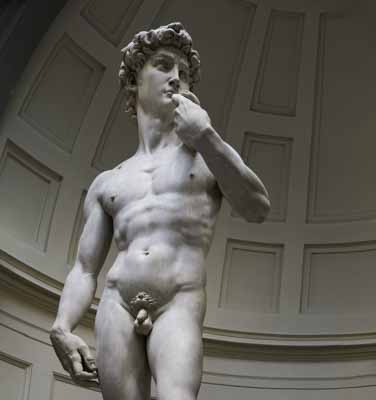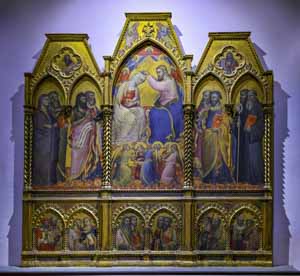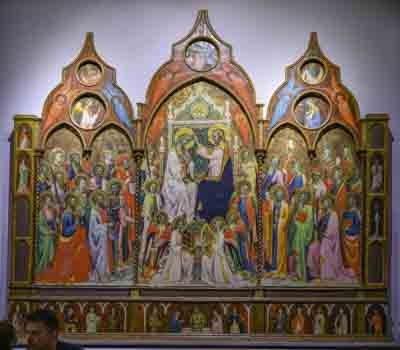Galleria dell’Accademia
| Michelangelo's David, created between 1501 and 1504, is a masterpiece of Renaissance sculpture representing the biblical hero David. Standing at 5.17 meters, it was originally intended for the Florence Cathedral but was later placed in the Piazza della Signoria. The statue symbolizes strength and youthful beauty, becoming an icon of Florentine civic pride. David showcases Michelangelo's profound understanding of anatomy and human expression. |
Lorenzo di Niccolò, Angels and Saints
| The altarpiece Coronation of the Virgin, Angels and Saints was painted in 1401 for the church of Santa Felicita in Florence by Spinello Aretino, Niccolò di Pietro Gerini, and Lorenzo di Niccolò. The painting is a large tempera on wood panel depicting the Virgin being crowned Queen of Heaven by the Redeemer. The altarpiece is known for its lively interpretation of the subject, particularly in the depiction of the musical angels dancing around the throne. Medieval instruments being played by the angels (L-R): pipe, drums, bagpipe, vielle, and lute. |
Rossello di Jacopo Franchi, Coronation of the Virgin
| The polyptych Coronation of the Virgin with Angels and Saints is a tempera on wood panel painted in 1420 by Rossello di Jacopo Franchi. It was originally located in the Santa Maria di Le Campora monastery in Florence. The polyptych consists of three main panels united by a frame, with intricate cymatia and small pilasters on the sides. There are four musical angels on the central panel, playing pipe, organ, harp, and a partially viewable zither. This work is a testament to the magnificence of Late Gothic altarpieces. |
Jacopo di Cambio, Coronation of the Virgin between Angels and Saints
| Jacopo Cambi's exceptional embroidery adorned the main altar of Santa Maria Novella church in Florence. This masterpiece, one of the finest examples of Florentine embroidery from the 1300s, showcases a composition likely based on drawings influenced by Giotto but infused with Gothic elements. Highly prized during its time, this extraordinary piece represents a pinnacle of historical and artistic importance in textile craftsmanship. It is also a rare 14th century example depicting musical instruments of the Middle Ages (L-R): symbals, vielle, pipe, pipe, vielle, and tambourine. |
| |



